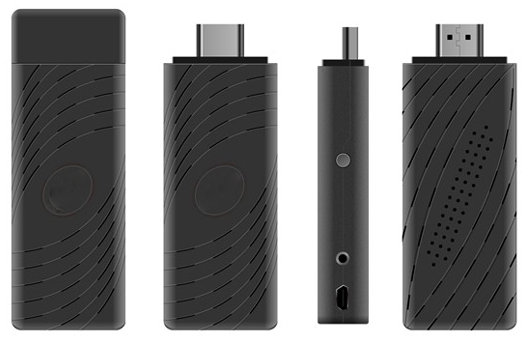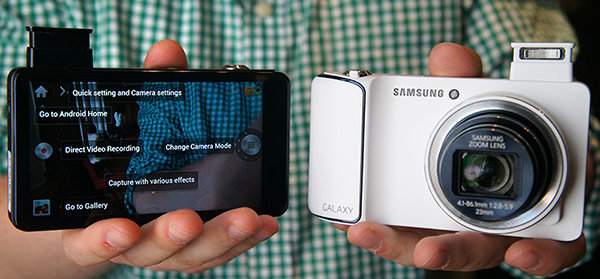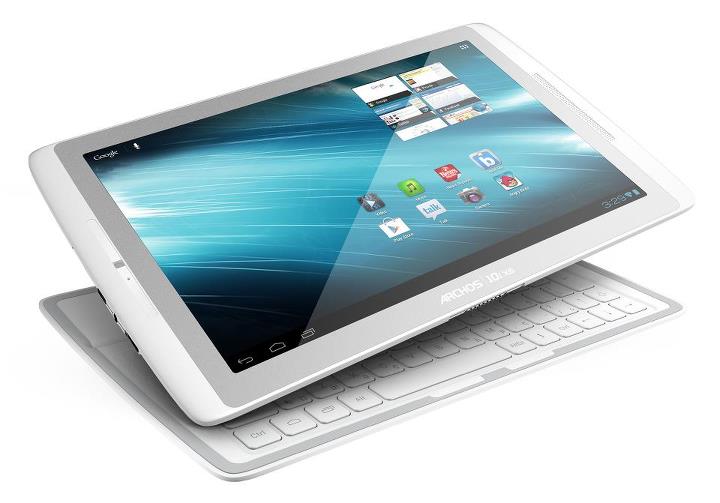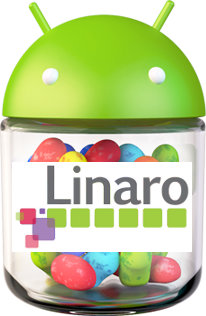Since it was first announced in August, Rockchip RK3066 dual core mini PCs have been popping up everywhere, and AFAIK those are currently the only low cost (sub $100) dual core Android TV Sticks available. But according to a recent Kimdecent announcement, this is about to change with the release of the Droid Stick A2 based on AMLogic AML8726-MX Dual Core Cortex A9 processor with 1GB RAM and 4 to 8 GB Flash running Android Jelly Bean. Here are Droid Stick A2 specifications: CPU – Amlogic AML8726-MX Dual Core Cortex A9 @ 1.5 GHz GPU – Mali400 Dual Core, 2D/ 3D/ OpenGL ES2.0/ OpenVG1.1. System Memory – 1 GB RAM Storage – 4/8 GB Nand Flash + microSD card slot (up to 32GB) WiFi – 802.11b/g/n Video Output – HDMI (1080P) Video Decoding – Supports up to 1920x1080p@60fps Video Encoding – Supports encoding in H.264. 1080p@60fps, 720@100fps USB – 1xUSB […]
Linaro 12.09 Release with Kernel 3.6 and Android 4.1.1
Linaro release 12.09 has just been announced, and includes Linux Kernel 3.6-rc6 and Android Jelly Bean. This release provides further improvement to Android Jelly Bean, Android benchmark characterization, an ARMv8 OpenEmbedded image, UEFI bootloader support for Vexpress, origen and pandabords, and some improvement to big.LITTLE and power management. Here are the highlights of the release: Android All Linaro patches are now available on Jelly Bean. Accelerated graphics is now available on Snowball Jelly Bean build. AndEBench, AndEBench Java, Linpack, CaffeineMark, Antutu 2D and 3D, NBench, Quadrant, I/O Benchmark, Vellamo benchmark hotspot characterization available. An Origen tracking build is available and will be released this cycle as a Linaro Evaluation Build (LEB). Audio works on Origen running Jelly Bean (WAV file only). A Monkeyrunner script to run Streamline has been completed. First rev of the NI PXIe-4154 based power measurement system is created. See http://www.youtube.com/watch?v=9bKyuxLl4iw&feature=plcp In-tree AOSP tests have been automated. […]
Linaro 12.08 Release with Kernel 3.6 and Android 4.1.1 Jelly Bean
Linaro release 12.08 includes Linux Kernel 3.6-rc2 and is the very first release with Android Jelly Bean (4.1.1-R4). The Android platform team has managed to port Android Jelly Bean to all their main development platforms: Versatile Express, Versatile Express RTSM, Samsung Origen, TI PandaBoard, ST Ericsson Snowball, as well as Samsung Galaxy Nexus smartphone. They’ve also added TINY_ANDROID, a minimal Android build that can be used for kernel development, toolchain work and other development where users only need a console. It’s possible to get the source code, build it and access the shell within 10 minutes. U-boot-Linaro has been updated and is now based on the latest upstream release v2012.07. Next month, we might be able to see a preliminary port of Android on 64-bit platform (ARMv8). Here are the highlights of the release: Android Automated Methanol (http://gitorious.org/methanol) browser benchmarking in Linaro Android. Automated over 100 Jelly Bean AOSP tests. […]
Samsung Unveils EK-GC100 Galaxy Camera Running Android 4.1
Following Nikon steps with its Coolpix S800c, Samsung announced their own Android camera. Samsung EK-GC100 camera features an Exynos 4412 quad core Cortex A9 processor, a 4.8″ touchscreen display (1280×720), Wi-Fi and 3G or 4G connectivity (depending on model), a 16MP camera with a 21X optical zoom, and runs Android Jelly Bean. Samsung Galaxy Camera specifications: OS – Android 4.1 (Jelly Bean) Processor – 1.4GHz Quad-Core processor Memory – 8GB + memory slot : micro SDSC, micro SDHC, micro SDXC Display – 121.2 mm (4.8″), 308 ppi, HD Super Clear Touch Display Image Sensor – 16.3 effective megapixel 1/2.3″ BSI CMOS Lens – F2.8, 23 mm, 21x super long zoom IS – OIS (cnxsoft: what is that?) (Optical Image Stabilization) – See Ganesh comment below for details explanation, in case you don’t know this. ISO – Auto, 100, 200, 400, 800, 1600, 3200 Network – 4G, 3G (HSPA+ 21Mbps): 850 […]
Rowboat Releases Android 4.1.1 Jelly Bean for Beagleboard-XM and Beaglebone
Rowboat announced a preliminary version of Android 4.1.1 (Jean Bean) for beagleboard and beaglebone platforms last week. These releases support SGX (3D graphics acceleration) on both Texas Instruments Sitara AM37x processor (Beagleboard-XM) and AM335x processor (Beaglebone), and all download and build instructions are available on their Wiki: Jellybean On Beagleboard JellybeanOn Beaglebone – Tested with LCD7 cape. If you could not care less about building it yourself, Rowboat provides pre-built binaries that you can install on a micro-SD card (4GB and greater) as follows : For Beagleboard-XM (DVI output):
|
1 2 3 4 |
curl http://rowboat.googlecode.com/files/beagleboard-xm-jb.tar.gz > beagleboard-xm-jb.tar.gz tar -zxvf beagleboard-xm-jb.tar.gz cd ~/beagleboard_xm-jb sudo ./mkmmc-android.sh <Your SD card device e.g:/dev/sdc> |
For Beaglebone (with 7″ LCD Cape):
|
1 2 3 4 |
curl http://rowboat.googlecode.com/files/beaglebone-jb.tar.gz > beaglebone-jb.tar.gz tar -zxvf beaglebone-jb.tar.gz cd ~/beaglebone-jb sudo ./mkmmc-android.sh <Your SD card device e.g:/dev/sdc> |
The full source is available on rowboat gitorious account, but there are lots of repo over there, so the best way to get the source is probably the “repo init” instructions in the 2 links above. Jean-Luc Aufranc (CNXSoft)Jean-Luc started CNX Software in 2010 as a part-time endeavor, before quitting his job as […]
Archos Unveils 101 XS Tablet Powered by TI OMAP4470
After teasing us last March, Archos officially launched their new Gen10 XS tablet line, and specifically announced the Archos 101 XS, a 10.1-inch Android 4.0.3 tablet powered by Texas Instruments OMAP4470 (Dual core Cortex A9) @ 1.5 GHz that features a detachable magnetic keyboard called the CoverBoard which also serves as a protective cover when not in use. Here are the specs for this new tablet: Processor Texas Instruments OMAP4470 @ 1.5GHz with SGX544 GPU Storage 16 GB Flash Memory + microSD Slot (up to 128GB) System Memory 1GB RAM Video codecs and containers • H.264 HD ([email protected], up to 1080p@30 fps and 1080i/720p@60 fps) • MPEG-42 HD (SP/ASP@L6, up to 1080p@30 fps) • With optional plug-in: MPEG2 HD (MP/HL, 1080p@30 fps) • With the above codecs, the device can play video files with the following extensions: AVI, MP4, MOV, 3GP, MPG, PS, TS, VOB, MKV, FLV, RM, RMVB, ASF […]
Instructions to Build Android Jelly Bean on Pandaboard and Origen Boards
About 2 weeks ago, Linaro showed Android Jelly Bean running on Origen board with hardware accelerated, and last week they provided instruction to build Jelly Bean for the Pandaboard (OMAP4430) and the Origen board (Exynos 4212). Android Jelly Bean for Pandaboard: Pre-build Image and Build Instructions The fastest way to try Android Jelly Bean on the Pandaboard is to download the latest binaries available at https://android-build.linaro.org/builds/~linaro-android/panda-jb-gcc47-tilt-stable-blob in a PC running Ubuntu. For example (12/08/2012): wget http://snapshots.linaro.org/android/~linaro-android/panda-jb-gcc47-tilt-stable-blob/24/target/product/pandaboard/system.tar.bz2 wget http://snapshots.linaro.org/android/~linaro-android/panda-jb-gcc47-tilt-stable-blob/24/target/product/pandaboard/boot.tar.bz2 wget http://snapshots.linaro.org/android/~linaro-android/panda-jb-gcc47-tilt-stable-blob/24/target/product/pandaboard/userdata.tar.bz2 Install linaro-image tools: sudo add-apt-repository ppa:linaro-maintainers/tools sudo apt-get update sudo apt-get install linaro-image-tools Insert an SD card, make sure it is not mounted and flash it with the firmware (Replace /dev/sdc by the corresponding drive in your system): ./linaro-image-tools/linaro-android-media-create –mmc /dev/sdc –dev panda –system system.tar.bz2 –userdata userdata.tar.bz2 –boot boot.tar.bz2 Finally install the graphics libraries: wget http://people.linaro.org/~vishalbhoj/install-binaries-4.0.4.sh chmod a+x install-binaries-4.0.4.sh ./install-binaries-4.0.4.sh Remove the SD card from your PC, and insert it […]
MIPS Releases Android 4.1.1 (Jelly Bean) Source Code
At the end of last month, MIPS announced the $125 Karbonn Mobiles Android Jelly Bean Tablet powered by Ingzenic MIPS-Based JZ4770 SoC. Today, they released Android 4.1.1 source code for MIPS Before downloading the Android source code, make sure you have a properly setup Linux workstation. Here are the instructions to checkout MIPS Android 4.1.1:
|
1 2 3 4 |
mkdir mipsandroid cd mipsandroid repo init -u git://github.com/MIPS/manifests.git -b dev-mips-jb -m mips-jb-4.1.1_r1.xml repo sync |
You can read the release notes for more details about the current status of the MIPS Android Jelly Bean port. Myriad Dalvik turbo, an alternative Dalvik implement that is much faster than the default Dalvik engine (at least on MIPS), is not yet available for Android 4.1, but should be soon. All MIPS Android source code can also be viewed online at http://www.github.com/mips. Jean-Luc Aufranc (CNXSoft)Jean-Luc started CNX Software in 2010 as a part-time endeavor, before quitting his job as a software engineering manager, and starting to write daily news, and reviews full time […]







